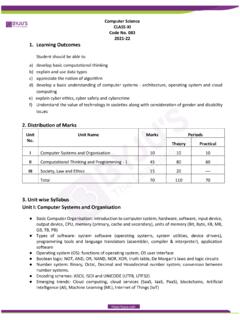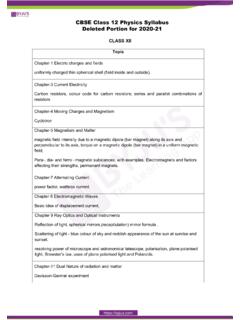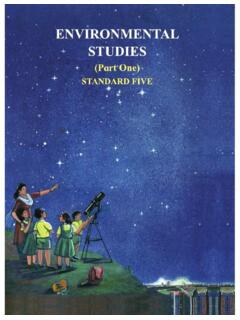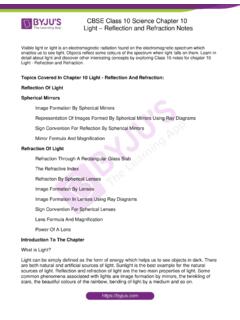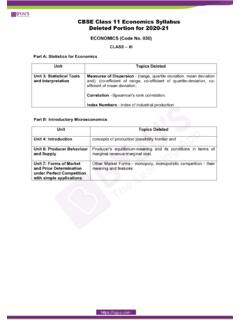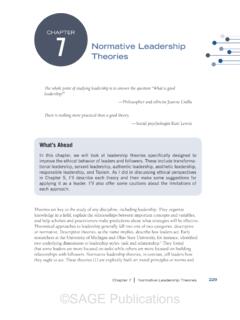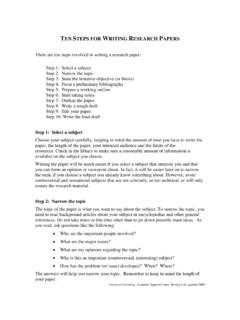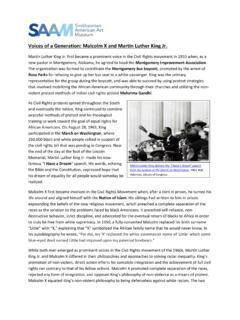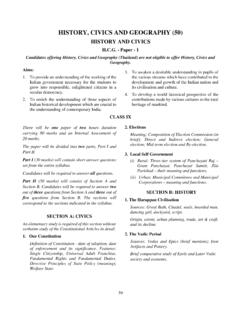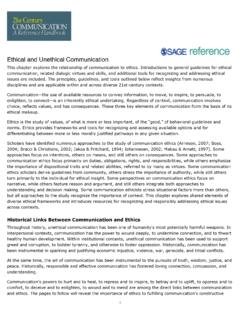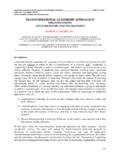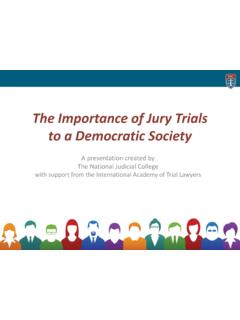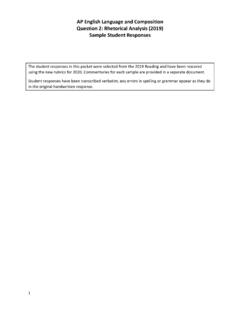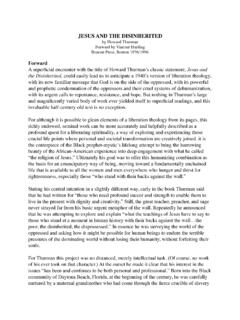Transcription of ICSE Class 10 History and Civics Reduced Syllabus for the ...
1 1 History , Civics AND GEOGRAPHY (50) History AND Civics - Paper - 1 Candidates offering History , Civics and Geography (Thailand) are not eligible to offer History , Civics and Geography. Class X There will be one paper of two hours duration carrying 80 marks and an Internal Assessment of 20 marks. The paper will be divided into two parts, Part I and Part II. Part I (30 marks) will contain short answer questions set from the entire Syllabus . Candidates will be required to answer all questions. Part II (50 marks) will consist of Section A and Section B. Candidates will be required to answer two out of three questions from Section A and three out of five questions from Section B. The sections will correspond to the sections indicated in the Syllabus .
2 SECTION A: Civics Union LegislatureMeaning of the federal setup in India.(i)Lok Sabha - term, composition, qualificationsfor membership. Parliamentary procedures: abrief idea of sessions, quorum, question hour,adjournment and no-confidence election.(ii) Rajya Sabha composition, qualifications formembership, election, term, and functions of Union Parliament (legislative, financial and control over theexecutive). Exclusive powers of the Union Executive(a) The President:Qualifications for election, composition ofElectoral College, reason for indirectelection, term of office, procedure (executive, legislative, discretionaryand emergency).(b)The Vice-President:Qualifications for election and term of office.
3 (c)Prime Minister and Council of Ministers:Appointment, formation of Council ofMinisters and their tenure. Position andpowers of the Prime Minister. Collective andindividual responsibility of the members of theCabinet. Distinction between the Council ofMinisters and the The Judiciary(a)The Supreme Court:Composition, qualifications of judges, andtheir appointment; Jurisdiction and functions:Original, Appellate, Advisory, Revisory,Judicial Review and Court of of Fundamental Rights andWrits.(b) The High Courts:Composition, qualifications of judges andtheir appointment.(c)Subordinate Courts:Distinction between Court of the DistrictJudge and Sessions Adalats: meaning and B: History Indian National Movement (1857 - 1917)(a)The First War of Independence, 1857 Only the causes (political, socio-religious,economic and military).
4 [The events,however, need to be mentioned in order tomaintain continuity and for a morecomprehensive understanding.](b)Factors leading to the growth of Nationalism socio-religious reform movements (briefICSE Class 10 History and Civics Reduced Syllabus for the Year 2022 2 mention of contribution of Raja Rammohan Roy and Jyotiba Phule) and role of the Press. Indian National Congress - Immediate objectives of the Indian National Congress - the first two sessions and their Presidents should be mentioned. (c) First Phase of the Indian National Movement (1885-1907) Objectives and methods of struggle of the Early Nationalists. Any two contributions of Dadabhai Naoroji, Surendranath Banerjee and Gopal Krishna Gokhale.
5 (d) Second Phase of the Indian National Movement (1905-1916) Brief mention of the causes of the Partition of Bengal and its perspective by the Nationalists. Objectives and methods of struggle of the Radicals. Any two contributions of Bal Gangadhar Tilak, Bipin Chandra Pal and Lala Lajpat Rai. The Muslim League and its objectives. 2. Mass Phase of the National Movement (1915-1947) (a) Mahatma Gandhi - Non-Cooperation Movement : causes (Khilafat Movement, Rowlatt Act, Jallianwala Bagh Tragedy), programme and suspension Chauri Chaura incident and impact of the Movement; the Civil Disobedience Movement: causes (reaction to the Simon Commission, Declaration of Poorna Swaraj at the Lahore Session of 1929), Dandi March, programme and impact of the Movement, Gandhi-Irwin Pact and the Second Round Table Conference; the Quit India Movement: causes (failure of the Cripps Mission, Japanese threat), Quit India Resolution and the significance of the Movement.
6 (b) Forward Bloc (objectives) and INA (objectives and contribution of Subhas Chandra Bose). (c) Independence and Partition of India Mountbatten Plan (clauses and its acceptance) and the Indian Independence Act of 1947 (clauses only). 3. The Contemporary World (a) The First World War Causes (Nationalism and Imperialism, division of Europe and Sarajevo c risis) and Results (Treaty of Versailles). (b) Rise of Dictatorships Similarity between the ideologies of Fascism and Nazism. (c) The Second World War Causes (Dissatisfaction with the Treaty of Versailles, Rise of Fascism and Nazism, Japanese invasion of China, Failure of League of Nations and Hitler s invasion of Poland).
7 (d) United Nations (i) The objectives of the The composition and any four functions of the General Assembly, the Security Council, and the International Court of Justice. (ii) Major agencies of the United Nations: UNICEF, WHO and UNESCO any four functions only. (e) Non-Aligned Movement Brief meaning; objectives; Names of the architects of NAM. [Jawaharlal Nehru, President Nasser, Joseph Broze Tito]. INTERNAL ASSESSMENT Any one project/assignment related to the Syllabus . Suggested Assignments Compare the Parliamentary and Presidential forms of Government with reference to India and the Conduct a mock Court and record the proceedings. Present a life sketch and contributions of any one of the following Presidents of India Dr.
8 Rajendra Prasad, Dr. S. Radhakrishnan and Dr. Abdul Kalam (or any other). Present a book review of any one of the following works: Dadabai Naoroji s Poverty and un-British rule in India , Gandhi s The Story of my Experiments with Truth , Nehru s Discovery of India , Bhagat Singh s Why I am an Atheist , Vijayalakshmi Pandit s The Scope of Happiness: 3 A Personal Memoir , Abdul Kalam s Wings of Fire . Discuss the relevance of any one of the following films to understand the History of 20th Century Europe: The Book Thief, Schindler s List, Escape to Victory, The Boy in Striped Pyjamas, Life is Beautiful, The Sound of Music, Gandhi (Richard Attenborough), Sardar (Ketan Mehta), Netaji Subhas Chandra Bose - The Forgotten Hero (Shyam Benegal).
9 Highlight the work and achievements of any one Nobel Laureate - Malala Yousafzai or Kailash Satyarthi. Make a PowerPoint presentation on India s Independence and Partition. Make a presentation on the influence of Gandhian principles on Martin luther king / Nelson Mandela. Prepare a report on the contributions of any one of the following agencies of the United Nations UNESCO / WHO / UNICEF / ILO / UNDP / FAO. Present a case study of any recent human rights violations and redressal mechanisms available to prevent such instances in the future. EVALUATION The assignments/project work is to be evaluated by the subject teacher and by an External Examiner. (The External Examiner may be a teacher nominated by the Head of the School, who could be from the faculty, but not teaching the subject in the section/ Class .)
10 For example, a teacher of History of Class VIII may be deputed to be an External Examiner for Class X, History projects.) The Internal Examiner and the External Examiner will assess the assignments independently. Award of Marks (20 Marks) Subject Teacher (Internal Examiner) 10 marks External Examiner 10 marks The total marks obtained out of 20 are to be sent to the Council by the Head of the School. The Head of the school will be responsible for the online entry of marks on the Council s CAREERS portal by the due date. 4 INTERNAL ASSESSMENT IN History & Civics - GUIDELINES FOR MARKING WITH GRADES Grade Preparation/ Research Information Concepts Thinking Skills Presentation Marks I Follows instructions with understanding.
